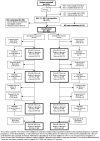Long-term impact of acyclovir suppressive therapy on genital and plasma HIV RNA in Tanzanian women: a randomized controlled trial
- PMID: 20235836
- PMCID: PMC2948536
- DOI: 10.1086/651696
Long-term impact of acyclovir suppressive therapy on genital and plasma HIV RNA in Tanzanian women: a randomized controlled trial
Abstract
Background: Herpes simplex virus (HSV) suppressive therapy reduces genital and plasma human immunodeficiency virus type 1 (HIV-1) RNA over periods up to 3 months, but the long-term effect is unknown.
Methods: A total of 484 HIV-1 and HSV type 2 seropositive Tanzanian women aged 16-35 years were enrolled in a randomized placebo-controlled trial of acyclovir administered at a dosage of 400 mg twice daily. Cervico-vaginal lavage and blood samples were collected at 6 months, 12 months, and 24 months for quantification of genital and plasma HIV-1 RNA and genital HSV DNA. Primary outcomes were detection and quantity of cervico-vaginal HIV-1 RNA at 6 months.
Results: At 6 months, there was little difference between the acyclovir and placebo arms for cervico-vaginal HIV-1 RNA detection (88 [ 41 .3%] of 213 vs 84 [ 44 .0%] of 191; odds ratio [OR], 0.90; 95% confidence interval [CI], 0.60-1.33), HSV DNA detection (20 [ 9 .4%] of 213 vs 22 [ 11 .5%] of 191; OR, 0.80; 95% CI, 0.42-1.51), genital HIV or HSV loads, or plasma HIV-1 RNA load. Estimated median adherence was 91%. There was a suggestion of an impact on cervico-vaginal HIV-1 RNA detection among women with estimated adherence 90% (OR, 0.74; 95% CI, 0.50-1.09) when data from all 3 visits were included.
Conclusions: Acyclovir administered at a dosage of 400 mg twice daily is unlikely to be a useful long-term intervention to reduce HIV transmission. The lack of effect on HIV may be attributable to suboptimal adherence or treatment regimen.
Figures
Comment in
-
Adherence in HIV type 1 prevention trials.J Infect Dis. 2010 May 1;201(9):1279-81. doi: 10.1086/651697. J Infect Dis. 2010. PMID: 20235837 No abstract available.
-
Time to refocus on HSV interventions for HIV prevention?J Infect Dis. 2011 Dec 15;204(12):1822-6. doi: 10.1093/infdis/jir653. Epub 2011 Oct 12. J Infect Dis. 2011. PMID: 21998480 Free PMC article. No abstract available.
Similar articles
-
Impact of aciclovir on genital and plasma HIV-1 RNA in HSV-2/HIV-1 co-infected women: a randomized placebo-controlled trial in South Africa.AIDS. 2009 Feb 20;23(4):461-9. doi: 10.1097/QAD.0b013e32831db217. AIDS. 2009. PMID: 19155993 Free PMC article. Clinical Trial.
-
Impact of acyclovir on genital and plasma HIV-1 RNA, genital herpes simplex virus type 2 DNA, and ulcer healing among HIV-1-infected African women with herpes ulcers: a randomized placebo-controlled trial.J Infect Dis. 2009 Jul 15;200(2):216-26. doi: 10.1086/599991. J Infect Dis. 2009. PMID: 19530940 Clinical Trial.
-
High-dose valacyclovir decreases plasma HIV-1 RNA more than standard-dose acyclovir in persons coinfected with HIV-1 and HSV-2: a randomized crossover trial.J Acquir Immune Defic Syndr. 2013 Jun 1;63(2):201-8. doi: 10.1097/QAI.0b013e3182928eea. J Acquir Immune Defic Syndr. 2013. PMID: 23542637 Free PMC article. Clinical Trial.
-
Infectious co-factors in HIV-1 transmission herpes simplex virus type-2 and HIV-1: new insights and interventions.Curr HIV Res. 2012 Apr;10(3):228-37. doi: 10.2174/157016212800618156. Curr HIV Res. 2012. PMID: 22384842 Free PMC article. Review.
-
Potential effect of HIV type 1 antiretroviral and herpes simplex virus type 2 antiviral therapy on transmission and acquisition of HIV type 1 infection.J Infect Dis. 2005 Feb 1;191 Suppl 1:S107-14. doi: 10.1086/425272. J Infect Dis. 2005. PMID: 15627220 Review.
Cited by
-
Addition of Acyclovir does not affect Adherence to HAART in HIV-1/ HSV-2 Co-Infected Women.J AIDS Clin Res. 2010 Dec 22;1(4):1000113. doi: 10.4172/2155-6113.1000113. J AIDS Clin Res. 2010. PMID: 21572917 Free PMC article. No abstract available.
-
Volatile Acid-Solvent Evaporation (VASE): Molecularly Homogeneous Distribution of Acyclovir in a Bioerodable Polymer Matrix for Long-Term Treatment of Herpes Simplex Virus-1 Infections.J Drug Deliv. 2018 Sep 26;2018:6161230. doi: 10.1155/2018/6161230. eCollection 2018. J Drug Deliv. 2018. PMID: 30356432 Free PMC article.
-
The role of coinfections in HIV epidemic trajectory and positive prevention: a systematic review and meta-analysis.AIDS. 2011 Aug 24;25(13):1559-73. doi: 10.1097/QAD.0b013e3283491e3e. AIDS. 2011. PMID: 21633287 Free PMC article.
-
Current trends in negative immuno-synergy between two sexually transmitted infectious viruses: HIV-1 and HSV-1/2.Curr Trends Immunol. 2012;13:51-68. Curr Trends Immunol. 2012. PMID: 23355766 Free PMC article.
-
Effect of genital herpes on cervicovaginal HIV shedding in women co-infected with HIV AND HSV-2 in Tanzania.PLoS One. 2013;8(3):e59037. doi: 10.1371/journal.pone.0059037. Epub 2013 Mar 13. PLoS One. 2013. PMID: 23516595 Free PMC article.
References
-
- Gray RH, Wawer MJ, Brookmeyer R, et al. Probability of HIV-1 transmission per coital act in monogamous, heterosexual, HIV-1-discordant couples in Rakai, Uganda. Lancet. 2001;357:1149–53. - PubMed
-
- Baeten JM, McClelland RS, Corey L, et al. Vitamin A supplementation and genital shedding of herpes simplex virus among HIV-1-infected women: a randomized clinical trial. J Infect Dis. 2004;189:1466–71. - PubMed
-
- Mbopi-Keou FX, Gresenguet G, Mayaud P, et al. Interactions between herpes simplex virus type 2 and human immunodeficiency virus type 1 infection in African women: opportunities for intervention. J Infect Dis. 2000;182:1090–6. - PubMed
-
- McClelland RS, Wang CC, Overbaugh J, et al. Association between cervical shedding of herpes simplex virus and HIV-1. AIDS. 2002;16:2425–30. - PubMed
Publication types
MeSH terms
Substances
Associated data
Grants and funding
LinkOut - more resources
Full Text Sources
Medical


